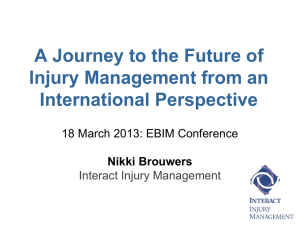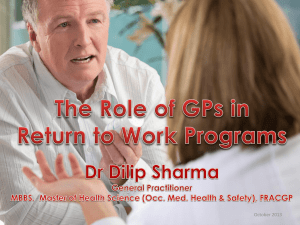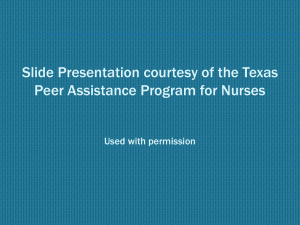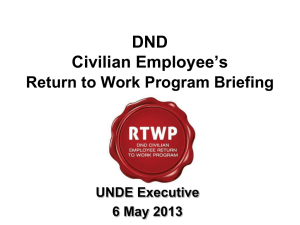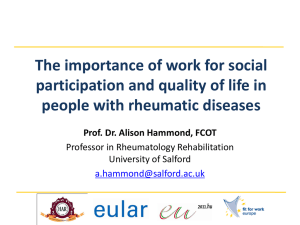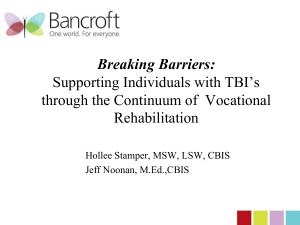Click here to the Strategies for Success
advertisement
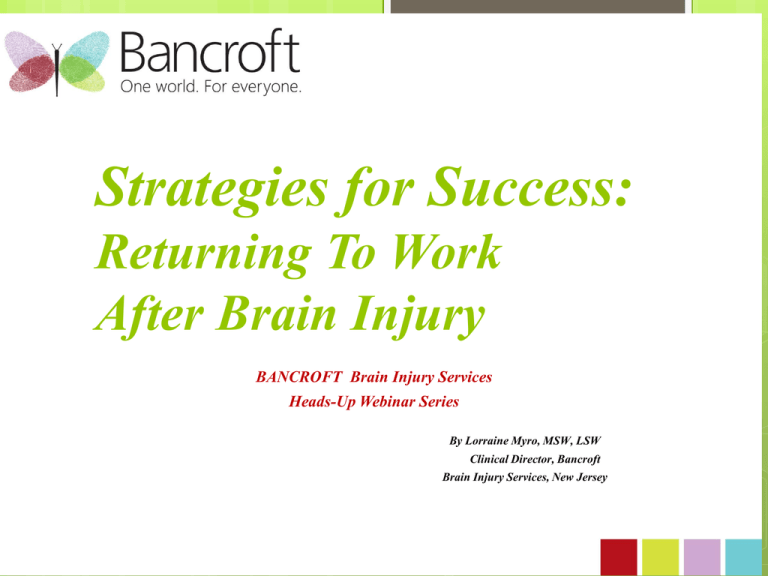
Strategies for Success: Returning To Work After Brain Injury BANCROFT Brain Injury Services Heads-Up Webinar Series By Lorraine Myro, MSW, LSW Clinical Director, Bancroft Brain Injury Services, New Jersey Our Mission Bancroft provides opportunities to children and adults with diverse challenges to maximize their potential. . Our Vision A community where every individual has a voice, a purpose and a rightful place in society. Our Core Values Responsible Empathetic Supportive Passionate Empowered Committed Trustworthy RESPECT 2 3 Re-Cap of May Webinar: Finding the Perfect Job Reviewed the significance of volunteer and employment positions as related to quality of life Identified Community resources and services available to support the vocational process Identified challenges encountered when helping individuals with acquired brain injuries find their “Perfect Job” Explored how to utilize brain injury outcome measures (the MPAI-4) as an effective assessment tool to determine job compatibility Today’s Objectives Identify what percentage of individuals with TBI are returning to work, as well as the limitations of the research Identify limiting and facilitating factors for returning to work Identify what employers need from us to engage in successful partnerships Identify key elements that support successful return to work programming People who are employed report . . . Better sense of well-being Better health status Greater social integration within the community Less health service usage More social contacts Overall better quality of life Van Helzen, Van Bennekom, Edelaar, Sluiter, & FringsDresen, 2009 Factors affecting return to work rates (RTW) o o o o o o o Invisibility of injury Economic conditions Specific employer hiring strategies Employer attitudes Continuing symptoms Life changes Lack of information provision, advice and guidance re: RTW Van Helzen, Van Bennekom, Edelaar, Sluiter, & FringsDresen, 2009; Hernandez, Chen, Araten-Bergman, Levy, Kramer, Rimmerman, 2012 7 Limitations of research Reviews published 2007 - 2011 Challenges with the studies Definition of “return to work” o • • o Same job, other job, studies, homemaker FT/PT Length of RTW employment to be considered “successful RTW” Distinguishing ABI vs. TBI Range of measures (6 months, 1 year, 2 years) Severity of injury Contradictory findings Return to work rates 10 studies, international TYPE OF INJURY RATE MILD (6 weeks – 9 months) 12 – 87.5% MIXED (> 1 year) 45 – 66% SEVERE (> 1 year) 18 – 37 % Shames, Treger, Ring & Giaquinto, 2007 Influence of race/ethnicity on RTW post ABI Race/ethnicity independently predicts employment outcomes after ABI Example: African Americans twice as likely as whites to be nonproductive 1 year postinjury Minorities, as a group, more likely than whites to not be competitively employed at 1 year postinjury Wehman, Gentry, West, Arango-Lasprilla, 2009 RTW Predictive Factors Length of stay ADL functioning Injury severity Self-awareness Motivation Shames, Treger, Ring, & Giaquinto, 2007; Van Helzen, Van Bennekom, Edelaar, Sluiter, & Frings-Dresen, 2009 Qualitative Predictive Factors Patient’s positive valuation of work Flexible and supportive workplace Higher scores on neuropsychological screenings Subscale for Affect discriminated o o o o Ability to express an affect with the voice Interpret facial emotional expressions Ability to control emotional impulses Ability to comprehend and express response to humor Hofgren, Esbjornsson, & Sunnerhagen, 2010 Most prevalent barrier for RTW Inappropriate behavior Behavioral outbursts Lack of tact Disinhibition Shames, Treger, Ring & Giaquinto, 2007 RTW Barriers Continued Self-report Tiredness/fatigue Lack of support from colleagues, supervisors Recovery time took too long Unable to drive Physical consequences (vision, hearing, balance, pain) Cognitive consequences (aphasia, concentration) Van Velzen, Van Bennekom, Van Dormolen, Sluiter, & Frings-Dresen, 2011 RTW Facilitating Factors Self-report Motivation* Strong will* Support from colleagues and bosses Goodness of fit for job task Humor* Functional use of upper extremities* Van Velzen, Van Bennekom, Van Dormolen, Sluiter, & Frings-Dresen, 2011 15 Clinical Implications for Successful Program Planning Research identifies complex interactions between Pre-morbid characteristics Injury factors Post-injury impairments Personal and environmental factors 16 Programming for Success Commitment from Administrative team Business Advisory Council Support/partnership with vocational rehabilitation professionals Supported Employment/Customized Employment Inter-disciplinary team model Vocational Grand Rounds Utilization of strengths-based practices Personal Futures Planning Commitment from Administrative Team: Business Advisory Council o o Committee of local business representatives who come together to identify avenues for helping those with TBI get back into the work force. Purpose = network Zuger, Brown, O'Neill, Stack, Amitai, 2002 Why a Business Advisory Council? Groundbreaking research by Fraser, et al (2009) explored the hiring intentions and behaviors of nonprofit and for-profit organizations Follow up study identified differences in hiring strategies o o For-profit driven by mission to sell Nonprofit driven by mission to serve For-profit organizations: participants involvement with disability employment committees or networks seemed to foster hiring of individuals with a disability Hernandez, Chen, Araten-Bergman, Levy, Kramer, Rimmerman, 2012 Critical Elements of BAC Chair person who can attract and motivate members Committee members either are decision makers in their organization or have access to decision makers in local businesses Serve as advisors, advocates, liaisons, and educators Network Events Personal meet and greets Newsletter to the local community Zuger, Brown, O'Neill, Stack, Amitai, 2002 Benefits of a BAC . . . Networking Educate, break down barriers within the business community Employers can communicate about trends, their needs, make recommendations and referrals Advice about resumes Invite us to their functions, opportunities for company exposure, ambassador for clients Zuger, Brown, O'Neill, Stack, Amitai, 2002 21 Benefits for business professionals on a BAC . . . Develop awareness Exposed to cultural and sensitivity training Inspiration Opportunity to “shine” 22 Vocational Rehabilitation Specialists Comprehensive Evaluations o Recommendations based off of evaluations Situational assessments Work trials/Job coaching Problem solve, resources Therapeutic interventions Network, advocate, bridge gaps Most prevalent barrier for RTW Inappropriate behavior Behavioral outbursts Lack of tact Disinhibition Strategic interventions Tailor the environment o o Quiet, structured, routinized Structured, routinized, and loud Opportunity and space to take breaks as needed 24 Examples of strategies/therapeutic interventions Make building a resume a priority: volunteer and internships demonstrate individual’s strengths and capacities Modify working tasks/ work times to individual’s capabilities Work less hours/have sufficient time to recover Introduce adaptations to improve performance 25 Examples of strategies/therapeutic interventions Prolonged support for individual and employer Collaborate with inter-disciplinary team Make sure individual has name/# of on-site contact (and back-up contact) each time he/she goes to work Make sure individual has name/# of contact for transportation, when it should arrive and what to do if it doesn’t Emphasize pre-vocational work Volunteering o Opportunity to practice work skills Follow a structured schedule Build cognitive and physical stamina Improve upon skills Opportunity to practice accountability Opportunity for evaluation in a safe setting o Add to resume What do employers look for when hiring Goodness of fit Compatability/connection Understand what their needs are: business practices, trends, and outcomes their hiring process what their industry calls for from it’s workers how a carved out position can help them 28 What supports do employers need from us? Language they can understand and relate to, “The individual sustained an injury from a car accident” Education about TBI and individual’s capabilities Commitment from support team to individual’s success Availability to provide on-the-spot support Relationship Reliability of individual and support team Supported Employment 2009 study identified that “finding evidence that the approach is being utilized on a wide-scale basis by individuals with ABI is difficult” 2012 study indicated that “Individualized placement and the model of supported employment have been established as one of the most supported EBPs” Wehman, Gentry, West, & Arango-Lasprilla, 2009; Drebing, Bell, Campinell, Fraser, Malec, Penk, & Pruitt-Stephens, 2012 What is supported employment? Individualized and intensive support Provided by vocational rehabilitation professional Identify individual’s abilities and potential work place needs Contact employer to discuss hiring needs, including job seekers abilities, and specific tasks that employers need to have done Wehman, Gentry, West, & Arango-Lasprilla, 2009; Customized Employment ODEP explains CE as “individualizing the employment relationship between employees and employers in ways that meet the needs of both” Predicated on a “negotiation” between the job seeker (or his/her representative) and the employer; the means of getting the job differs from the traditional approach of applying, interviewing, orienting, and working. Griffin, Hammis, Geary, & Sullivan, 2008; Griffin & Keeton, 2009 Inter-disciplinary team model Inter-disciplinary team model Neuropsychologist Speech therapist Occupational therapist Physical therapist Cognitive rehabilitation therapist Employment specialists Vocational Rehabilitation specialists Person being served, significant others Physician Example of how an IDT model can work . . . Case Example: AC 38 yo, injured as a child, working at ACME for 10 years Lives in residential rehabilitation program, with full IDT Behaviors: Asking customers for puzzles Uniform chronically dirty Anger outbursts (yelling, cursing, stomping away) 34 Strategies used: • • • • • Employment Specialist met with management to assure them team was addressing issues; followed up to ensure improvement Bring uniform to Day Program daily, include a clean back-up uniform that is kept on-site Staff pre-set AC of expectations o Change into work clothes right before work o Do not ask customers for puzzles Therapy with neuropsychologist Initial response to interventions: angry outbursts o Calm, consistent implementation of strategies o Eventually outbursts ceased o Problematic behaviors ceased 35 AC’S WORK PREPARATION CHECKLIST Each day that AC works, staff will review this checklist with him. Both AC and staff will initial the box as they review the item. Our support with this responsibility is critical to AC keeping his job. Items to Review __________ Wearing ACME uniform __________ Pants are clean __________ Shirt and Vest are clean __________ Apron is clean and on __________ Review reminders REMINDERS IN ORDER TO STAY EMPLOYED WEAR A CLEAN UNIFORM FOR THE FULL SHIFT IF THEY ASK YOU TO WEAR YOUR ACME JACKET WHILE YOU ARE WORKING, BE SURE TO WEAR DO NOT ASK CUSTOMERS FOR ANYTHING BE RESPECTFUL AND POLITE TO YOUR BOSS BE RESPECTFUL AND POLITE TO YOUR CO-WORKERS IF YOUR BOSS ASKS YOU TO DO SOMETHING, BE SUPPORTIVE BY SAYING “YES” AND DOING IT 36 Inter-disciplinary team support o o o o o Vocational specialist: liaison between AC, team and employer; provided on-site support until issues resolved Residential program manager sent clothes in with AC Day program manager: trained staff on protocol Staff: pre-set AC daily Neuropsychologist: source for AC, support with pre-setting IDT: Vocational Grand Rounds Similar to medical model of grand rounds Gathering of professionals involved in vocational rehabilitation that focuses discussion on unique or problematic cases Offer expertise from across the spectrum • • • • • • • Neuropsychologists Vocational specialists Counselors Funder Community business leaders Advocates Individual * Zuger, Brown, O'Neill, Stack, Amitai, 2002 Benefits of Vocational Grand Rounds • • • Outreach Education Development/strengthening of relationships with community resources Zuger, Brown, O'Neill, Stack, Amitai, 2002 Strengths-based Practice: Personal Futures Planning o o o o Person – centered approach to treatment planning Assumes that vocational goals are defined, achieved, and retained within a broad context Focus on vision and action plan to address all areas of life that are important to individual Vision and goals are adapted to fit life with challenges and new reality Zuger, Brown, O'Neill, Stack, Amitai, 2002 In the words of one client, “Following my accident, society seemed to say to me, ‘Drop out of life, take your medication and maybe we can find you a job in a file room somewhere.’ PFP helped clear the psychosocial logjam that inhibited the flow of my personal development.” Zuger, Brown, O'Neill, Stack, Amitai, 2002 41 Clinical practice going forward: Using our resources o o o o o Utilize the MPAI to highlight strengths and skill areas Categorize types of employment, compare with strengths and weaknesses of MPAI Implement principles of customized employment Utilize resources from BAC Implement previously identified strategies • • • Comprehensive assessment Inter-disciplinary treatment Job coaching, supported employment, job mentor 42 MPAI-4 Tool to Assess Job Compatibility Extrapolate results from MPAI Executive Functioning Memory Attention Social Communication Visuospatial Physical Ability MPAI Tool to Assess Job Compatibility Person Served: Job Title: Organization: Hours: LOS: Assessor: 0 None Date: MPAI Scoring Rubric 1 Mild problem 2 Mild problem; 3 Moderate but does not interferes with problem; interfere with activities 5-24% interferes with activities; may of the time activities 25-75% use assistive of the time device or medication Executive Functioning Functional Area/Correlating MPAI Rating PS Rating 11. Novel problem-solving 20. Impaired self-awareness 22. Initiation Total Job 3 3 3 2 2 2 9 6 4 Severe problem; interferes with activities more than 75% of the time With Aid? Y/N Y/N Y/N 44 MPAI-4 Tool to assess job compatibility 45 Treatment Plan Long term goal: Employment Short term goal: Reduce MPAI rating for selfawareness from 3 to a 2 Interventions: • • • • • • • Cognitive therapy Speech therapy Individual psychology sessions Group psychology sessions Situational assessment at potential work site Monthly team meetings to monitor progress Job coaching at each work sessions Critical elements of successful RTW Network, network, and then network some more! Commitment from all members of the team, including administrative team Defined roles and expectations of anyone involved Thorough and accurate understanding of individuals injury, strengths, interests and impairments o History, evaluations, situational functioning Persistence, creativity, and commitment Zuger, Brown, O'Neil, Stack, Amitai, 2002 Considerations to improve RTW outcomes RTW possibility and process should be discussed with family and team early in postacute recovery Embrace RTW principle: everyone is employable when provided with the right opportunities and supports; RTW is a process rather than event Increase use of supported employment Consider alternative forms of employment: tele-work, selfemployment, independent contracting work Expand efforts to help raise awareness of the centrality of employment outcomes : RTW should be a primary outcome for rehabilitative services Wehman, Gentry, West, & Arango-Lasprilla, 2009; Debring, Bell, Campinell, Fraser, Malec, Penk & PruittStephens, 2012 48 Further research on this topic . . . • • • • • What types of jobs are people “returning to”? Has the practice of customized employment impacted RTW rates? Has the utilization of Business Advisory Councils impacted RTW rates? Has the use of assistive technology impacted RTW rates? Why do minorities have lower RTW rates than whites? 49 Questions? Lorraine.myro@bancroft.org “… no matter how broken or deformed the body of a human being may be, within that body is a personality, and it is our business to liberate that body from its prison – to remove the obstructions that prevent the assertion of expression of the individuality” Margaret Bancroft The Collected Works of Margaret Bancroft, 1915
